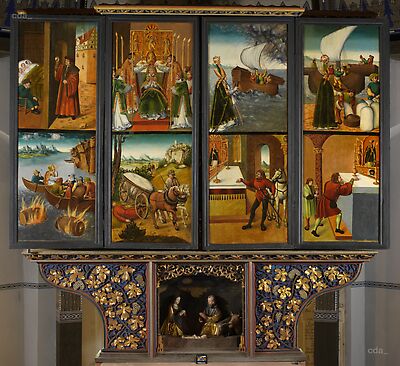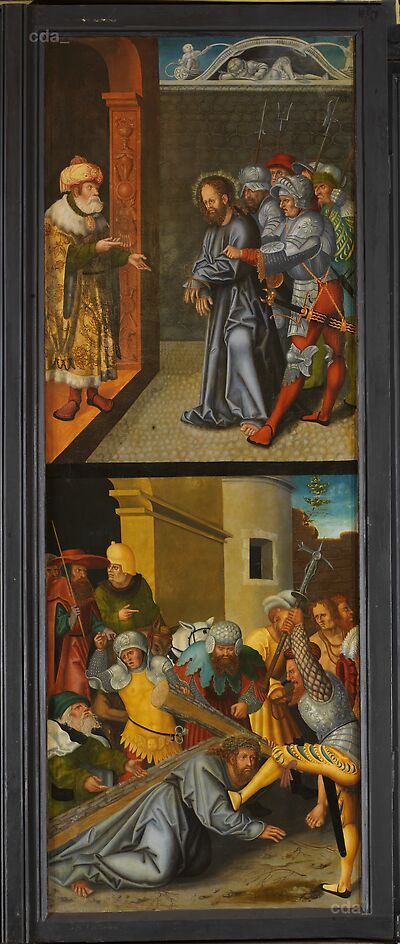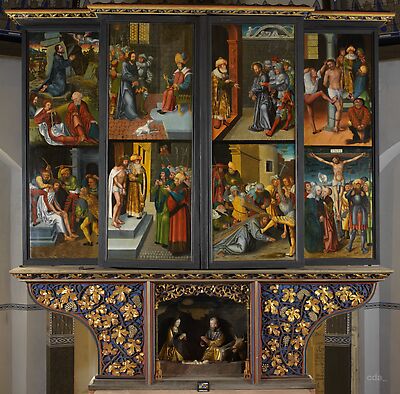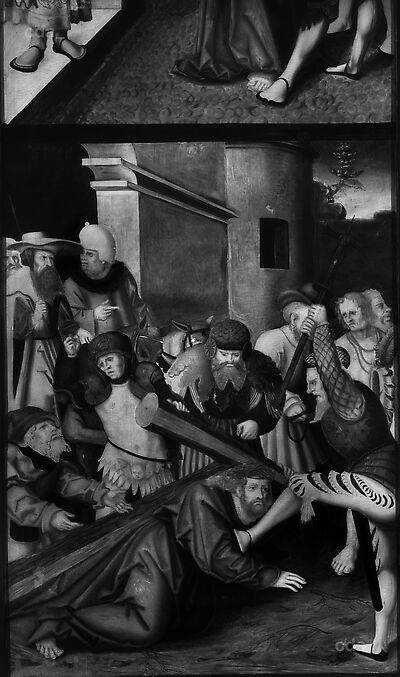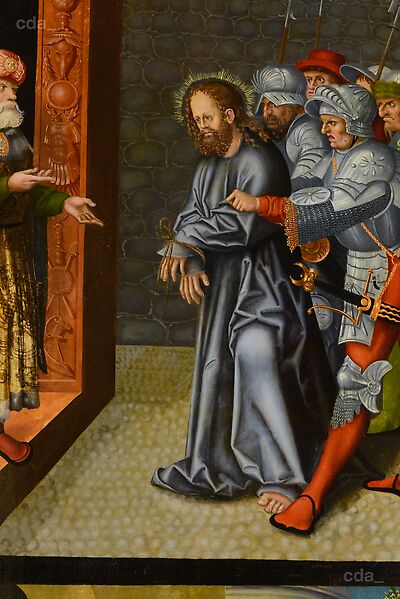The outer wing panels of the altar depict Christ's passion, while the inner wing panels (the 1st transformation) illustrate the Legend of St Nicolas. The shrine contains almost life-size wooden statues of various bishops, among them St Nicolas.
Like in Döbeln the church patron St Nicolas is the centre piece of
The outer wing panels of the altar depict Christ's passion, while the inner wing panels (the 1st transformation) illustrate the Legend of St Nicolas. The shrine contains almost life-size wooden statues of various bishops, among them St Nicolas.
Like in Döbeln the church patron St Nicolas is the centre piece of the open altar. Beside him rank Erasmus [...] and a bishop holding a book and a ciborium (?) (Donatus of Arezzo?). The wings of the shrine contain saints Barbara and Margaret on the left and on the right Christopher, the patient bearer of 'divine burden', and a saint whose attribute is now lost (Leonard?). The predella contains a relief representation of the Nativity with a painted scene of the Annunciation to the Shepherds in the background.
The St Nicolas series, which is the most complete version in Saxony, faithfully illustrates the stages of the saint's life. However some of the more popular miracles are missing.
This panel depicts (on the inner side):
- upper field: during a great famine a ship was in the port at anchor, loaded with wheat for the Emperor in Constantinople. Nicholas asked the sailors to unload a part of the wheat to help in the time of need. The sailors at first disliked the request, because the wheat had to be weighed accurately and delivered to the Emperor. Only when Nicholas promised that they would suffer no loss for their generosity did they agree. When they arrived later in the capital, they discovered that the weight of the load had not changed.
- lower field: this depicts a rich man before St Nicolas' altar, requesting the birth of a son. He promised to donate the church a golden chalice for the favour. When the boy was born he liked the chalice he had commissioned so much that he had a second one made to take to the church of St Nicolas. Later his son fell into the water on a sea journey, while attempting to fill the original chalice. The father returned to St Nicolas' altarpiece and the second chalice fell repeatedly from the altarpiece until the son he presumed dead, but who had been saved by St Nicolas, appeared with the original chalice. Both chalices were then placed on the altarpiece.
on the exterior:
- upper field: Christ before Pilate
- lower field: Christ carrying the Cross
[Sandner 1993, 146-148]
![The Former Highaltar the Church of St Nicolas, Grimma: the Miracle of the Wheat; The Miracle of the Golden Chalice [interior of outer right wing, 1st transformation]; Christ before Pilate; Christ carrying the Cross [exterior of outer right wing, 2nd transformation]](https://lucascranach.org/imageserver-2022/DE_FKG_FKG001G_FR-none/01_Overall/DE_FKG_FKG001G_FR-none_2016-09_Overall-s.jpg)
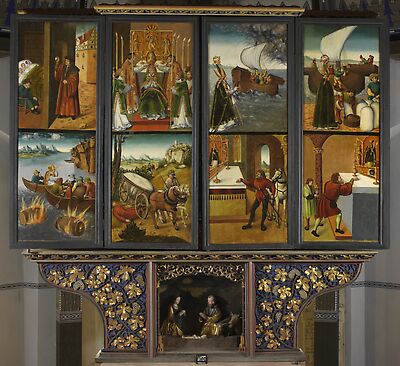
![The Former Highaltar the Church of St Nicolas, Grimma: Nicolas is made bishop of Myra; The Miracle of the Man run over by a Wagon [left inner wing, 1st transformation]](https://lucascranach.org/imageserver-2022/DE_FKG_FKG001D_FR-none/01_Overall/DE_FKG_FKG001D_FR-none_2016-09_Overall-s.jpg)
![The Former Highaltar the Church of St Nicolas, Grimma: St Nicolas saves the Sailors from the Stormt; A Knight with his Horse before St Nicolas' Altarpiece [right inner wing, 1st transformation]](https://lucascranach.org/imageserver-2022/DE_FKG_FKG001E_FR-none/01_Overall/DE_FKG_FKG001E_FR-none_2016-09_Overall-s.jpg)
![The Former Highaltar the Church of St Nicolas, Grimma: St Nicolas donates gold; St Nicolas as Protector of Pilgrims [interior of outer left wing, 1st transformation]; Christ before Caiaphas; Ecce Homo [exterior of outer left wing, 2nd transformation]](https://lucascranach.org/imageserver-2022/DE_FKG_FKG001F_FR-none/01_Overall/DE_FKG_FKG001F_FR-none_2016-09_Overall-s.jpg)
![The Former Highaltar the Church of St Nicolas, Grimma: The Arrest of Christ; The Mocking of Christ, [left fixed wing, 2nd transformation]](https://lucascranach.org/imageserver-2022/DE_FKG_FKG001H_FR-none/01_Overall/DE_FKG_FKG001H_FR-none_2016-09_Overall-s.jpg)
![The Former Highaltar the Church of St Nicolas, Grimma: The Flagellation; The Crucifixion, [right fixed wing, 2nd transformation]](https://lucascranach.org/imageserver-2022/DE_FKG_FKG001I_FR-none/01_Overall/DE_FKG_FKG001I_FR-none_2016-09_Overall-s.jpg)
